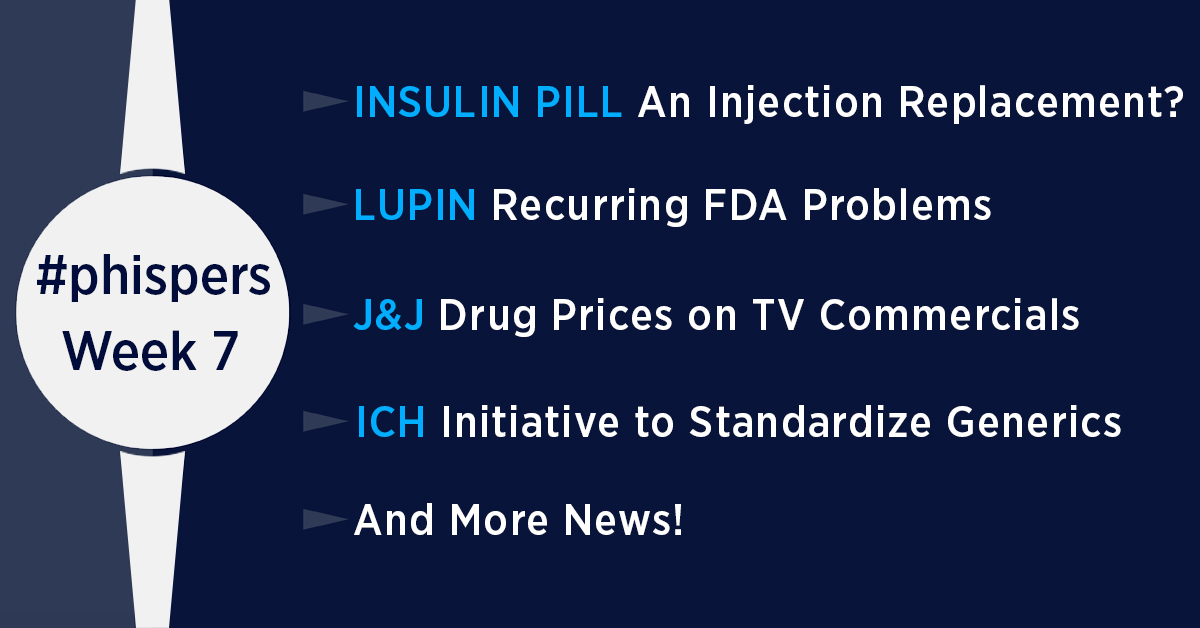
By PharmaCompass
2019-02-14
Impressions: 1946
This week, Phispers brings you news about a reflection paper released by the International Council on Harmonization (ICH) that seeks to standardize generic drugs across borders.
In the US, a federal jury has ordered Takeda to pay Bayer US$ 155.19 million for infringing a patent.
J&J to become the first company in the US to put list prices of its drugs in TV commercials, ahead of a proposed legislation to this effect.
An MIT-led research team has developed an insulin pill that could save millions of diabetic patients the trouble of taking injections.
After a warning letter issued to Lupin in 2017, an FDA Form 483 posted last week highlighted recurring compliance issues at the Indian drug major.
Leopard
tortoise-inspired insulin pill may help replace injections
An MIT-led research team has worked on an insulin pill that could save millions of diabetic patients across the world the pain and trouble of taking injections each day.
The capsule, also known as the ‘needle pill’, is inspired by leopard tortoise found in Africa. The leopard tortoise has a steep, domed shell that allows it to right itself if it rolls onto its back. The capsule, which is about the size of a blueberry, contains a small needle made of compressed insulin, which is injected into the stomach wall after the capsule has been swallowed.
The needle is attached to a compressed spring that is restrained by a disk made from sugar. The domed shape of the pill ensures that the needle is continually reoriented towards the stomach wall. Water in the stomach dissolves the disk, releasing the spring and injecting the needle into the stomach wall.
The stomach wall does not have pain receptors, so it is unlikely that this would cause any discomfort. The insulin needle takes about an hour to dissolve into the bloodstream.
When tested on animals, the drug was shown to deliver enough insulin to lower blood sugar to levels comparable to those produced by injections given through the skin. They also demonstrated that the device can be adapted to deliver other protein drugs.
Giovanni Traverso, an assistant professor at Harvard Medical School-affiliated Brigham and Women’s hospital and a co-author of the study, said: “Our motivation is to make it easier for patients to take medication, particularly medications that require an injection. The classic one is insulin, but there are many others.”
ICH releases
reflection paper on standardizing generic drugs
The International Council on Harmonization (ICH) released a reflection paper last week with an aim to harmonize the scientific and technical standards for generic drugs across borders.
The paper outlines recommendations to develop a series of ICH guidelines on standards for demonstrating equivalence (e.g., bioequivalence) for non-complex dosage forms and more complex dosage forms and products. To accomplish this work, the ICH has proposed to establish a generic drug discussion group to assist in assessing the feasibility of harmonization of standards for generic drugs and to prioritize work areas.
“At present, a lack of harmonized standards reduces the number of potential markets in which data and information submitted in support of a generic drug marketing application can be used by a developer to support marketing authorization in another jurisdiction,” the paper says. “This can lead to monopolies or limited sources of drugs in those markets in which approval is not sought due to the additional development burdens.”
The push for harmonization comes as the US Food and Drug Administration (FDA) recently noted a disconnect between countries in terms of which generics are available.
Harmonization may allow generic developers to use their data and meet multiple jurisdictions’ regulatory requirements for marketing authorization. Harmonization could also increase the size of the generic drug markets and attract more competition, which would mean lower costs and expanded patient access in jurisdictions in which developers otherwise may have decided not to pursue, the paper adds.
Lupin’s Form 483 reveals recurring compliance issues
In November 2017, Lupin had received a warning letter for its formulation manufacturing facilities in Goa and Indore (Pithampur Unit II). The observations of the inspections specifically highlighted Lupin’s continued “failure to thoroughly review any unexplained discrepancy” as Lupin invalidated approximately 96 percent of all out-of-specification (OOS) results obtained at Pithampur and over 75 percent of them in Goa.
Last week, following a recent FDA inspection at its Indore (Pithampur Unit II) facility, the FDA posted the Form 483 issued to the facility, which has once again highlighted concerns over Lupin’s handling of OOS results.
In the case of Moxifloxacin Ophthalmic Solution, not only were Lupin’s investigation practices questioned, but the firm failed to conduct a detailed health-hazard assessment until the time of the inspection, six months after the original OOS result was obtained.
The Form 483 also mentions that Lupin’s Corrective and Preventive Actions (CAPA) were not scientifically sound.
In addition to Lupin’s deficient investigative practices, there were also concerns about the ability of its laboratory personnel to properly conduct the required analytical test. Moreover, there were concerns over Lupin’s maintenance of electronic data as access to the system was not adequately controlled.
Takeda to pay Bayer
US$ 155 million for patent infringement
In the US, a jury has ordered Japanese drug major Takeda Pharmaceutical’s Baxalta unit to pay Bayer AG US$ 155.19 million for infringing a patent related to a Baxalta hemophilia treatment.
Baxalta was based in Illinois before Shire Plc acquired the company in 2016. Takeda completed the acquisition of Shire last month.
Bayer said the infringement arose from Baxalta’s exclusive license agreement with Nektar Therapeutics, a San Francisco-based company that had done research with Bayer and knew about the patent, including through litigation in Germany.
Jurors in the federal court rejected Baxalta’s argument that the June 2016 patent on the treatment, Adynovate, was invalid. The award covered the period from June 14, 2016, to November 30, 2018. Jurors applied a royalty rate of 17.78 percent to a royalty base of US$ 872.84 million to arrive at the damages award.
Takeda said it was disappointed with the verdict and will consider the legal options before it. “As a company, we are committed to developing and commercializing products with the best interest of patients in mind, and without violating the intellectual property rights of third parties,” it added.
J&J to become
first company in the US to put list prices of drugs in TV commercials
In the US, Johnson & Johnson has put up a good example of self-regulation — it said it will put list prices of its drugs in their television commercials. This way, J&J would become the first pharmaceutical company to take that step, ahead of a proposed Trump administration rule that would force all pharma companies to add list prices to TV advertisements.
The pharmaceutical industry has largely opposed this proposed rule, arguing that few people pay the high list prices. Some people’s out-of-pocket costs, though, are based on list prices.
The first drug to see this change is Janssen’s oral anticoagulant Xarelto. By March, Janssen will add both the list price and the potential out-of-pocket costs to its TV commercials. The information will appear on screen at the end of the commercial and will include a website where people can enter insurance information to get more specific costs.
Without insurance, Xarelto costs US$ 450 to US$ 540 per month, depending on the pharmacy. About 1 million Xarelto prescriptions are filled in the US each month.
In a statement, J&J said it will add prices to its other medicines too. It plans to weigh patient and consumer feedback on the Xarelto changes as it rolls out the follow-ups.
Members of the trade association PhRMA have recommended that TV ads start listing a website that gives consumers possible out-of-pocket costs and list prices. Last month, Eli Lilly began listing a website in its ads for diabetes medicine Trulicity.
The PharmaCompass Newsletter – Sign Up, Stay Ahead
Feedback, help us to improve. Click here
Image Credit : #Phisper Infographic by SCORR MARKETING & PharmaCompass is licensed under CC BY 2.0
“ The article is based on the information available in public and which the author believes to be true. The author is not disseminating any information, which the author believes or knows, is confidential or in conflict with the privacy of any person. The views expressed or information supplied through this article is mere opinion and observation of the author. The author does not intend to defame, insult or, cause loss or damage to anyone, in any manner, through this article.”






